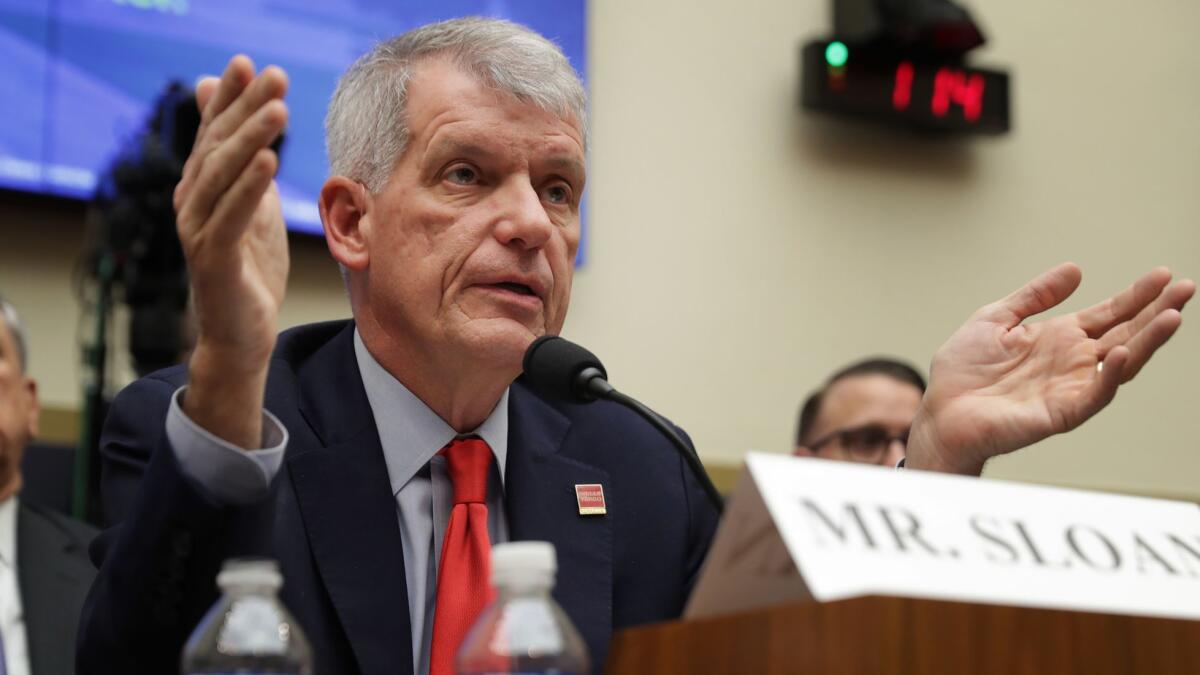Wells Fargo CEO Tim Sloan steps down as bank struggles to get past scandals

Reporting from Washington ‚ÄĒ Wells Fargo & Co.‚Äôs embattled chief executive, Tim Sloan ‚ÄĒ who has struggled to get the giant San Francisco bank past a seemingly endless series of customer abuse scandals ‚ÄĒ retired suddenly Thursday.
He stepped down as CEO, president and board member effective immediately, with his retirement taking effect June 30, Wells Fargo said.
His interim replacement will be C. Allen Parker, who has served as the company’s general counsel since March 2017 after joining the bank from an outside law firm. Wells Fargo said a permanent chief executive would be hired from outside the bank.
Sloan, a low-key Wells Fargo veteran of 31 years, took over the top job in 2016 amid the fallout over the bank’s acknowledgement that employees had opened millions of checking, savings and credit card accounts that customers never authorized.
He was a top executive at Wells Fargo when the accounts were being created as early as 2002, including stints as chief financial officer, chief operating officer and president. That led critics to argue he should have known about the problems long before they became public and was thus ill-suited to lead the bank out of its mess.
Sloan said Thursday that he was confident he could do the job but decided it was best to step aside. ‚ÄúThere‚Äôs just been too much focus on me and it‚Äôs impacting our ability to move forward,‚ÄĚ he said during a conference call with analysts.
Betsy Duke, chairwoman of Wells Fargo‚Äôs board of directors, said in a statement that Sloan had served the company ‚Äúwith pride and dedication‚ÄĚ and ‚Äúworked tirelessly‚ÄĚ since becoming chief executive ‚Äúfor all of our stakeholders in the best long-term interest of Wells Fargo.‚ÄĚ
In the conference call, she later said that ‚Äúseeking someone from outside is the most effective way to complete the transformation‚ÄĚ and acknowledged the bank has ‚Äúa lot more work to do.‚ÄĚ
Sloan is leaving with a retirement package worth about $52 million, according to a securities filing.
Ed Mierzwinksi, a consumer advocate with the U.S. Public Interest Research Group, said bringing in a new chief executive from outside Wells Fargo was needed to get past the scandals.
‚ÄúThe bank needs to be shaken up,‚ÄĚ he said. ‚ÄúThe bank needs new leadership that is responsive to both consumers and workers. It‚Äôs making a lot of money but it‚Äôs not changing its practices quickly.‚ÄĚ
Spokesmen for the bank’s two main federal regulators, who have been highly critical of Wells Fargo, declined to comment Thursday.
Wells Fargo announced Sloan’s retirement after markets closed on Thursday, sending shares up more than 2% in after-hours trading.
The Los Angeles Times first reported Wells Fargo’s high-pressure sales tactics in 2013.
Wells Fargo‚Äôs pressure-cooker sales culture comes at a cost ¬Ľ
The controversy was the first of several revelations about bank practices that have led it to pay about $4 billion in settlements with regulators, as well as plaintiffs who have brought private lawsuits. The Federal Reserve last year also hit Wells Fargo with an unprecedented cap on its growth until it could prove it had improved its corporate governance.
Sloan was tapped by the bank’s board of directors to try to repair Wells Fargo’s reputation and restore customer trust.
He replaced John Stumpf, who resigned as the bank’s longtime chief executive and board chairman in October 2016 just weeks after he was unable to defuse the anger of lawmakers at incendiary House and Senate hearings examining the fake-accounts scandal.
Sloan, the second Wells Fargo CEO to be felled by the scandal, could not stop the tide of troubles for the nation’s fourth-largest bank by total assets.
His struggles were highlighted at a contentious House Financial Services Committee hearing on March 10. Democrats and Republicans angrily rejected his message of contrition for the bank’s scandals and commitment to treating employees and customers right.
Rep. Maxine Waters (D-Los Angeles), the committee chairwoman, ended the hearing by declaring that ‚ÄúWells Fargo has failed to clean up its act.‚ÄĚ She said regulators should consider removing Sloan as chief executive and that she would reintroduce legislation directing regulators to downsize or even shut down banks with a pattern of violating consumer protection laws.
In a rare move, even one of the bank‚Äôs regulators, the Office of the Comptroller of the Currency, joined in the criticism, with a spokesman saying it was ‚Äúdisappointed with [Wells Fargo‚Äôs] performance under our consent orders and its inability to execute effective corporate governance and a successful risk management program.‚ÄĚ
The next day, Wells Fargo said in a securities filing that Sloan’s pay increased 4.9% last year to $18.4 million.
The news, in the wake of continued revelations about the bank’s bad behavior, led to more outrage. Waters called for Sloan to be fired, joining Sen. Elizabeth Warren (D-Mass.), who has been making that call since 2017.
The twin developments appeared to seal Sloan’s fate.
‚ÄúAbout damn time,‚ÄĚ Warren tweeted about Sloan‚Äôs departure. ‚ÄúTim Sloan should have been fired a long time ago. He enabled Wells Fargo‚Äôs massive fake accounts scam, got rich off it, & then helped cover it up. Now ‚ÄĒ let‚Äôs make sure all the people hurt by Wells Fargo‚Äôs scams get the relief they‚Äôre owed.‚ÄĚ
Ken Leon, bank analyst at CFRA, said that the OCC’s remarks about the slow pace of change at Wells Fargo were extraordinary and signaled that Sloan’s leadership was in trouble.
He said the board will probably wait to make a decision on a new chief executive until it receives more details from the Fed and OCC about their review of bank practices, which should provide guidance about how far along Wells Fargo is in changing its culture.
‚ÄúThe bank is not a distressed company, but it does need forward thinking,‚ÄĚ Leon said. ‚ÄúThis is a large bank that will not change quickly.‚ÄĚ
The first signs of big trouble at Wells Fargo came in late 2013, when a Times investigation found that the bank‚Äôs relentless pressure on employees to ‚Äúcross-sell‚ÄĚ checking and savings accounts, credit cards, mortgages and other financial products led to ethical breaches, customer complaints and labor lawsuits.
To meet sales quotas, employees opened accounts customers did not need, ordered credit cards without their permission and forged customer signatures on paperwork, according to a review of internal bank documents, court records and interviews with workers at bank branches.
‚ÄúThey‚Äôd just tell the customers: ‚ÄėYou‚Äôre getting a credit card,‚Äô‚ÄĚ Erick Estrada, a former Wells Fargo personal banker and business specialist at a Canoga Park branch, told The Times. He admitted to opening unneeded accounts, though he said never without a customer‚Äôs knowledge.
The Times article caught the attention of Los Angeles City Atty. Mike Feuer, who launched his own investigation. Also, in mid-2013, the Consumer Financial Protection Bureau began looking into Wells Fargo’s practices after receiving whistleblower tips.
In September 2016, Wells Fargo’s problems exploded into public consciousness when the bank agreed to pay $185 million to settle a lawsuit filed by Feuer and investigations by the consumer bureau and the Comptroller of the Currency.
The bank did not admit any wrongdoing even as it said its employees had opened as many as 2.1 million unauthorized accounts over a four-year period that ended in mid-2015. Wells Fargo publicly apologized to customers, vowed to pay refunds for fees on those accounts and announced steps to change its sales practices.
But the problems were just starting.
In the spring of 2017, Wells Fargo agreed to settle several class-action lawsuits over fake accounts for $142 million. That summer, the bank publicly said it might have created as many as 3.5 million unauthorized accounts going back to 2009.
Troubling revelations continued last year. The bank announced it would pay $80 million in refunds to hundreds of thousands of auto-loan borrowers who were forced to pay for bank-purchased auto insurance policies despite having coverage of their own.
Lawsuits were filed alleging other problems, including improperly changing the terms of mortgage loans for bankrupt borrowers, signing up customers for unauthorized life insurance policies and overcharging small businesses for credit- and debit-card processing services.
The accumulating troubles led one of the bank’s regulators to take a major step early last year.
The Fed ordered Wells Fargo to cap its growth and improve its corporate governance as a punishment for ‚Äúwidespread consumer abuses and other compliance breakdowns.‚ÄĚ
‚ÄúWe cannot tolerate pervasive and persistent misconduct at any bank, and the consumers harmed by Wells Fargo expect that robust and comprehensive reforms will be put in place to make certain that the abuses do not occur again,‚ÄĚ then-Fed Chairwoman Janet L. Yellen said in imposing the penalties.
Apparently in response to the Fed’s move, Wells Fargo said it would replace four board members.
As Wells Fargo settled suits and investigations, the price tag for the scandal continued to rise.
In September, a federal judge in San Francisco signed off on a $480-million settlement in a class-action shareholder lawsuit over the bank’s unauthorized-accounts scandal.
Three months later, Wells Fargo agreed to pay $575 million in a settlement with all 50 states and the District of Columbia to resolve investigations for practices dating to 2002. They included the fake accounts as well as charging improper mortgage rate-lock extension fees and forcing insurance policies on auto-lending customers.
To try to prevent future problems, Wells Fargo changed the way it paid tellers and other employees.
The bank announced in early 2017 that it was overhauling the system of incentives at the root of the unauthorized-accounts scandal. Wells Fargo said it would stop rewarding workers simply for opening accounts and judge them instead on how often customers used their accounts and on customer satisfaction.
But the day before Sloan‚Äôs March 12 congressional testimony, a report contended that the bank was backsliding on those reforms and ‚Äúhas not fixed its culture of fear and intimidation.‚ÄĚ
Some current and former employees said new customer-unfriendly sales incentives were reemerging, according to the report from the Committee for Better Banks, an advocacy group.
‚ÄúHonestly, it‚Äôs perceived as a joke ‚ÄĒ ‚ÄėOh yeah, they‚Äôve changed things,‚Äô ‚ÄĚ said Meggan Halvorson, 35, who works in Wells Fargo‚Äôs private mortgage banking division in Minneapolis. ‚ÄúI haven‚Äôt met anybody, personally, who believes what they‚Äôre saying or that it‚Äôs the case.‚ÄĚ
Wells Fargo spokesman Mark Folk disputed the thrust of the report, and in his testimony, Sloan acknowledged the bank’s troubles but said it was making progress in fixing them.
‚ÄúWe have more work to do and that is an ongoing commitment by all of Wells Fargo‚Äôs 260,000 team members ‚ÄĒ starting with me ‚ÄĒ to put our customers‚Äô needs first, to act with honesty, integrity and accountability; and to strive to be the best bank in America,‚ÄĚ Sloan told the House committee.
More to Read
Inside the business of entertainment
The Wide Shot brings you news, analysis and insights on everything from streaming wars to production ‚ÄĒ and what it all means for the future.
You may occasionally receive promotional content from the Los Angeles Times.











